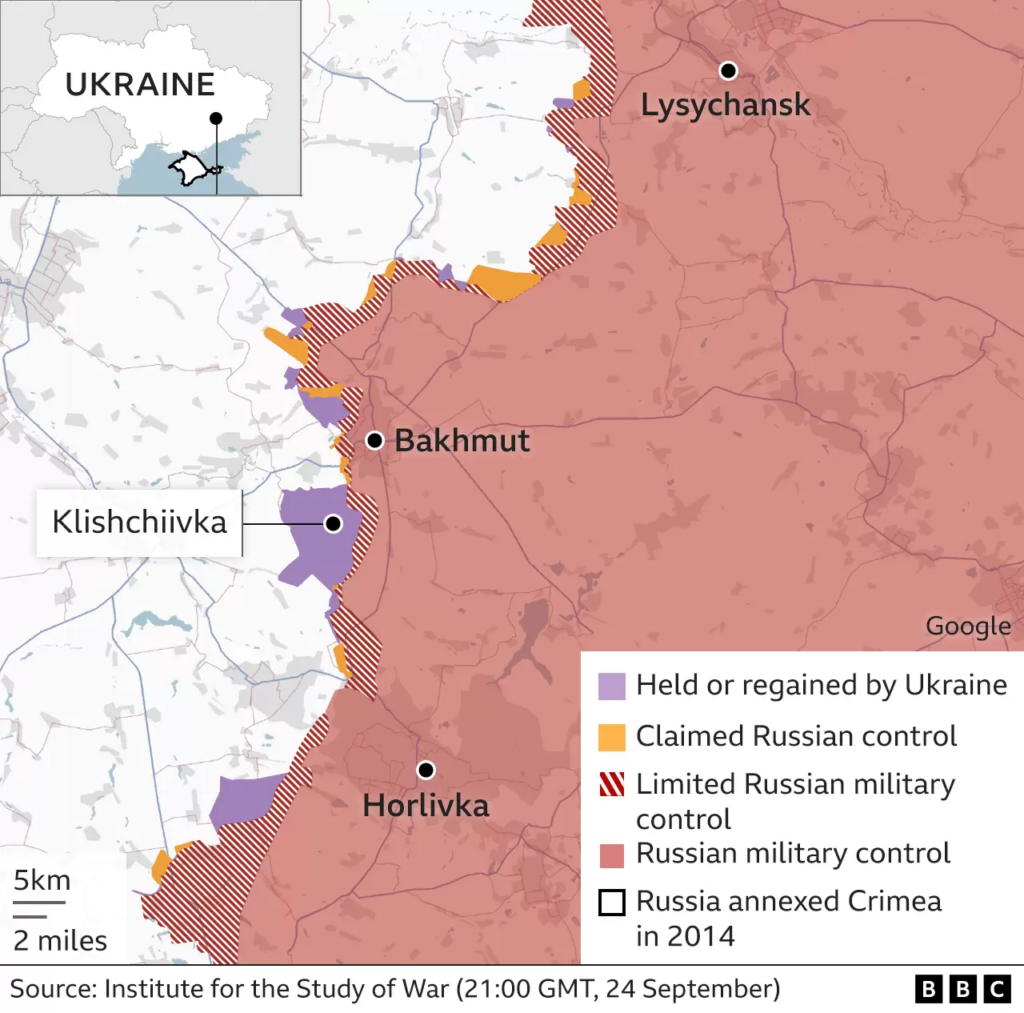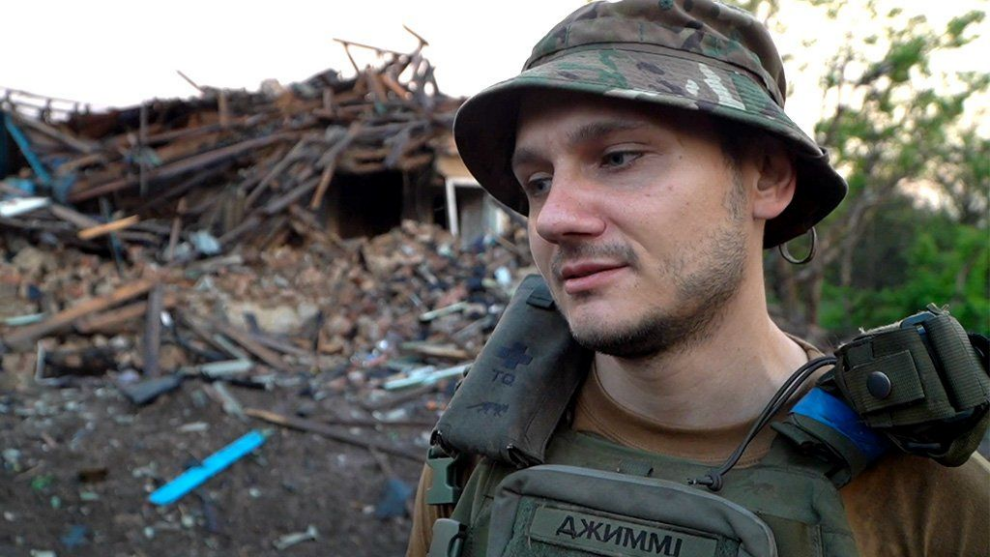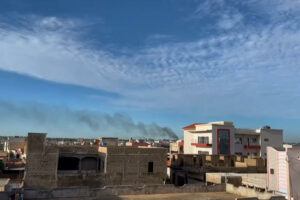Open-ended service, just 10 days leave a year and a high casualty rate – for Ukrainian soldiers in one unit, life on the front line is far from easy, as BBC Newsnight witnessed up close.
Standing among some flattened buildings, “Jimmy”, a Ukrainian officer who’s been on active service for years, reflected on his survival: “I’m a lucky man… as I see it, war can either love people or not.”
His soldiers think the fact Jimmy’s still with them, despite multiple wounds, means he lives a charmed life.
His unit, the 24th Mechanised Brigade, has a long history, and is part of the old regular Ukrainian army, fighting the Russians from 2014. But since the invasion of February 2022, the army has more than trebled in size, the nation mobilised and Jimmy’s unit changed out of all recognition.
We spent two weeks in August with the 24th, which now serves in the Donbas, that old centre of smokestack industries in the east, occupying a section of the front between Bakhmut and Horlivka.

And we went to the home community in western Ukraine where the brigade was garrisoned before the war, and where many of its families still live.
Jimmy – the Ukrainian army asks that we use soldiers’ nicknames rather than their real ones – commands a company (usually about 120 troops), a post he stepped into last year. One officer told me that none of the 15 company commanders in post at the start of the war are still in place, all having been promoted or become casualties.
In the run-up to war, the 24th Brigade was just over 2,000 strong, rotating its three battalions to the front line in eastern Ukraine for occasional tours of duty. Although the Ukrainian army rarely discusses numbers, sources told me it has now swelled to more than 7,000, with a total of five infantry battalions, four of artillery, a tank battalion and numerous other supporting elements.
As that mobilisation happened, the old regular soldiers were joined by thousands of volunteers and conscripts. “Yurii,” a twenty-something venture capitalist from Kyiv, is one of the talented incomers.

Initially given a rifle and sent to the infantry, a few months later, Yurii was transferred into a military “start-up”, the 24th Brigade’s strike drone company. Sitting at a table in a children’s playground near the front, he showed us new drones, and the packages of explosive they carry, allowing him and others to fly them into vehicles, buildings, or bunkers where the Russians are taking cover.
Yurii explained how his mother was initially sceptical about him joining up, but once he started guiding drones into Russian trenches, “then she changed her mind”, and became proud of him.
Under the terms of their contracts, volunteers – in common with conscripts – can’t walk away and are obliged to serve until the war ends. In the meantime, they are entitled to only 10 days’ leave each year.
Yurii is unusual among the 24th’s men in that the £2,600 ($3,195) he earns monthly (80% of which is combat pay) is less than his earnings in civilian life.
Bearded, and with a banker’s flair for selling a business plan, Yurii told me how the company has to be more ingenious than the Russians because the enemy have so many more drones.
One of the officers revealed that although Yurii ranks as a simple private soldier, he basically runs this unit. That rethinking of the usual hierarchy is one of the differences between the pre-2022 army set-up and the force that now fights the Russians.
Another is their willingness to overlook age and other factors that might have counted against volunteers before 2022. We met a sergeant nicknamed “Hryb” (it means mushroom) who had been put in charge of a self-propelled artillery gun.
He’s an older man, 52 to be exact, who did his army service more than 30 years ago. What could he know about modern warfare?
As it happens, the 24th Brigade’s 152mm Akatsiya (or Acacia) howitzers are so ancient that they’re the same kind as the one Hryb commanded while serving with the Soviet Army in East Germany in the early 1990s.
The shells we watched them firing were manufactured 40 years ago, and the crew have nicknamed the howitzer Babushka or Grandma. Who better to know her old quirks than Grandpa Hryb?
His decision to volunteer did not sit easily with his family. “They cried silently,” Hryb explained. “They said they would wait for me, that they loved me.”
Behind the summit declarations, of “as long as it takes”, are hundreds of thousands of Ukrainian families struggling along, managing their hopes and fears as the war passed its 18-month point without any end apparently in sight.
At a rehabilitation centre in Lviv for soldiers with life-changing injuries, I discussed the difficult exchanges when some of the less badly wounded tell their wives they want to return to the front.
“Many boys, well those who remained alive but lost a limb, also lost their family,” Pavlo, one of the patients, told me.
That conversation has been taking place within his marriage too, he says ruefully: “She thinks I have already done my duty.” Another man, wounded in a minefield during the recent counter-offensive, tells me that Ukrainian society has not yet woken up to how many damaged people there are now.
The record of death, maiming, and capture may well be affecting people’s willingness to serve. Recruitment is another topic on which Ukraine does not publish official figures.
However, among the men that we filmed being trained at Yavoriv and another range closer to the front, many were in their 40s, and quite a few in their 50s. Officers told us about the intense competition for younger recruits among various brigades.
It also emerged in August, following the sacking of officers supervising the call-up, that thousands of men were bribing their way out of it or being smuggled out of the country to avoid service.
Among those who volunteer willingly to go to the front are many who have lost their jobs in the economic crisis that’s accompanied the war and are attracted by the high pay that comes with being on the front line.
As for attempts to turn the tables on Russia this summer, in order to liberate occupied lands, the expectations of what the Ukrainian military could achieve were perhaps higher in the Pentagon than among the veterans of the 24th Brigade.
“An easy breakthrough is simply impossible,” Jimmy told us. “We are getting ready for a long-term war.”
Another of the brigade’s officers, the commander of one of its battalions, compared the conflict to Vietnam, implying it could last many years.
And as the fight goes on, so does the loss. Casualties are a matter of great sensitivity in Ukraine, it being against the law to publish figures. But the Pentagon estimated recently that 70,000 Ukrainians had been killed in the war, the great majority of them in the military.
From our analysis of social media and archive news reports, our conservative estimate would be that the 24th Brigade has lost something like 400 personnel in total. About 120 of these died during the fighting from 2014 to the start of 2022, the remainder since the Russian invasion.
It has also had scores or even hundreds of men captured, another difficult topic for the authorities, since prisoner swaps have been very limited in scale so far.
The wife of one prisoner of war told us that just 22 men from the 24th Brigade had returned so far and that all of the government departments she’s written to had given her the same message: “You should wait.”
The repatriation of prisoners of war is just one of many issues that will have to be negotiated once the guns fall silent. But the loss and public outrage at Russia’s actions have made it so much harder for Ukrainian politicians to agree to an armistice or peace deal that looks like a messy compromise.
At a cemetery on the outskirts of Lviv, we followed Natalia Nezhura as she placed fresh flowers on her brother Andrii’s grave. “I tried everything to stop him going to the front line,” she explained.
She breaks down as she tells me of her feelings of failure that she had not managed to do this.
She had hidden Andrii’s call-up papers, then, when that was not successful, used a connection to get him a firearms instructor’s job at the Yavoriv training ground, “but in the end most of the boys were sent to the front line”.
Andrii was killed earlier this year, when the 24th Brigade had units engaged in the battle for Bakhmut. Our conversation took place among the fluttering flags of many units that adorn the military plot in Lviv, a place where we counted more than 2,000 graves.
Those who imagine this loss and pain might engender a yearning for peace would be in for a rude shock. When I asked her how the war should end, Natalia replied: “I just want all Russians dead, I hate them with all my heart and soul,” adding, “how can you talk about peace when they killed so many of our people?”
For years, the old professional army managed an uneasy peace and occasional flare-ups along the line of contact with the Russians. But now everybody feels a stake in the conflict, and the attitudes we encountered among the soldiers and families of the 24th Brigade underlined the degree to which society as a whole has been mobilised and only a clear-cut victory is now acceptable to Ukrainians.
Source : BBC

















Add Comment